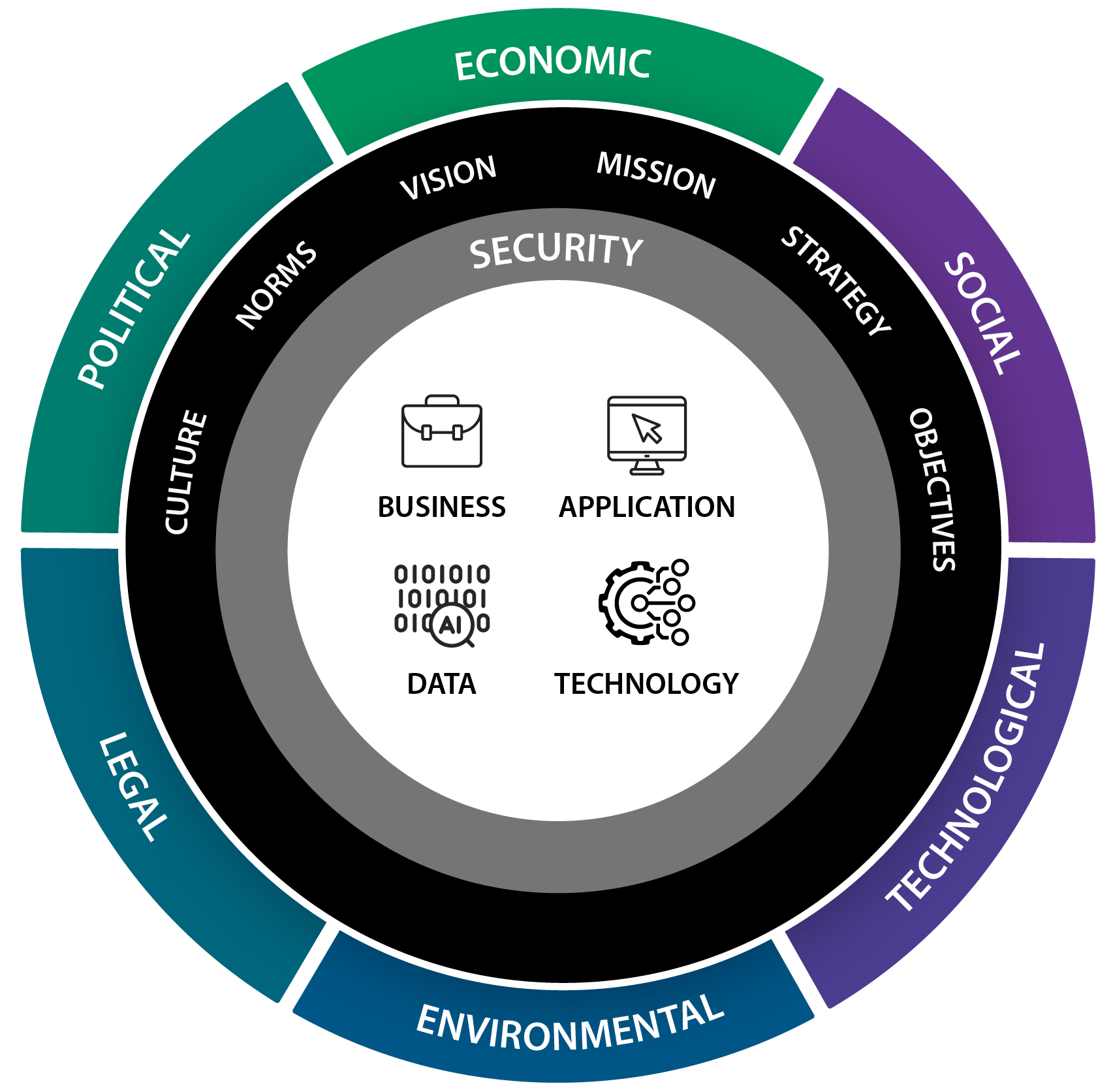Technology, when implemented properly, drives business growth and makes business processes efficient and effective. Laying an architectural foundation that sustains the changing trends gives a competitive edge. Enterprise Architecture helps in building that architectural foundation. Enterprise Architecture is a combination of overarching principles, processes, and frameworks to effectively and efficiently manage change in business and technology.
Here is the definition of Enterprise Architecture from Gartner’s IT Glossary: “Enterprise architecture (EA) is a discipline for proactively and holistically leading enterprise responses to disruptive forces by identifying and analyzing the execution of change toward desired business vision and outcomes. EA delivers value by presenting business and IT leaders with signature-ready recommendations for adjusting policies and projects to achieve target business outcomes that capitalize on relevant business disruptions.“
Why do we need Enterprise Architecture?
- Dealing with the Complexity of Systems: The Enterprise Architecture needs to be managed as the complexity of systems grows. This is closely related to the history and size of the organization; for instance, large, long-existing corporations usually have many legacy systems integrated with other systems (internal or external). In this case, we are dealing with a system of systems.
- Effective Change Management: Change is the only constant thing in organizations, and it needs to be managed effectively. Enterprises need to be adaptable to change without losing to competition. Enterprise-wide standards, frameworks, and best practices help manage change effectively.
- Effective Information Management: There is an exchange of information in any business transaction/process, and this information needs to be managed effectively. Enterprise Architecture framework helps in effective Enterprise Information Management (EIM).
Enterprise Architecture Myths
- Long-winded program with no tangible benefits: Enterprise Architecture efforts are typically multi-year large programs covering several projects under them. Just like any other program/project, the scope needs to be managed with critical success factors and agreed-upon measurable benefits. It boils down to following a disciplined approach (documented Architecture Vision, charter, meticulous planning, scope, critical success factors, tangible benefits, expected deliverables, etc.). Well, the results do not always have to be tangible (examples: ease of communication between stakeholders, transformation to a process-centric organization, consistency, etc.).
- Enterprise Architecture is glorified Solution Architecture: This myth originates from the lack of visibility into the breadth covered and deliverables produced by Enterprise Architects or bad experience with an Enterprise Architect who jumps into Solution Architecture. Enterprise Architecture projects are typically very strategic in nature and extend across functional boundaries of organizations. Enterprise Architecture is a discipline that deals with translating the strategy and operating model of an enterprise into detailed principles, practices, frameworks, standards, and processes for efficient and effective interaction and information exchange between various parts of the system by taking into account various concerns and viewpoints to deliver value now and in the future. The design goal of the enterprise is to sustain change and to be agile. Solution architecture, on the other hand, deals with designing solutions for unique business requirements by following frameworks, practices, and processes designed by an Enterprise Architect or industry-standard best practices.
Enterprise Architecture belongs to the IT domain: The Enterprise Architecture involves three major domains (according to TOGAF): Business, Information Systems (Application, Data), and Technology. Security Architecture cuts across these domains. Unless the scope only involves IT (Application, Data, Technology, and Security), Enterprise Architecture involves designing “future state” Business Architecture as well, and there is a body of work involved as part of this. We need to keep in mind that Information Systems exist to serve the business purpose. In addition to this, Enterprises operate in an Environmental Context (PESTEL): Political, Economic, Social, Technological, Environmental, and Legal. The Organization and its culture influence the principles and practices.

Enterprise Architecture Tips
- Have a Roadmap: Before embarking on an Enterprise Architecture program, it’s highly recommended that IT and Business leaders discuss current challenges, agree on the future state and high-level roadmap with deliverables, business outcomes, and tangible/intangible benefits from each phase within the roadmap.
- Document Current and Future State: Ensure that all the current business and IT processes are documented in detail. Document the future state, at least in plain simple English along with business outcomes. Bring the consultant only for the work that you cannot manage internally. This reduces the chaos and “analysis” time drastically.
- Manage Change: Large enterprise transformation programs demand effective change management to deal with people and political aspects. Communication is the key to managing change. Prepare the team for change by engaging key stakeholders upfront and have the message percolated down to lower levels. Communicate the challenges that we need to overcome and the ultimate benefits. Seek feedback and make course corrections. Typical reasons for politics include functional silos, possible role changes, disagreement between different stakeholders on the priorities, benefits, and other aspects.
- Establish EA Governance Organization: A large Enterprise Architecture program needs a Governance Organization with representation from Business and IT. The Governance Organization typically has Executive Sponsorship at the top and a Working Committee at the bottom, having a major role in reviewing the projects under the EA program and seeking sponsorship, assigning Architects to an EA project, reviewing the EA deliverables, planning the Development and Implementation, etc.
- Build custom framework: According to ISO, “An architecture framework establishes a common practice for using, creating, interpreting, and analyzing architecture descriptions within a particular domain of application or stakeholder community. ISO/IEC/IEEE 42010 formalizes a framework as a set of predefined, interconnected viewpoints.“
According to TOGAF, “An architecture framework is a foundational structure, or set of structures, which can be used for developing a broad range of different architectures. It should describe a method for designing a target state of the enterprise in terms of a set of building blocks, and for showing how the building blocks fit together. It should contain a set of tools and provide a common vocabulary. It should also include a list of recommended standards and compliant products that can be used to implement the building blocks.“
There were different EA frameworks developed over time, and they serve different purposes. If a framework does not fit specific needs, it’s highly recommended to build a custom framework by taking relevant items from multiple frameworks. The custom framework can cover dimensions such as Process, Presentation, and Evolution. Blindly following the industry-standard EA frameworks without understanding the business context is a step towards failure.
- Measure Success: Enterprise Architecture is criticized as too theoretical, and its value is not visible/realized. It’s like blaming the discipline of Civil Engineering instead of the Civil Engineer for a building collapse. Due diligence, approach, and expertise level of the Enterprise Architect make a difference.
- Typical outcomes of Enterprise Architecture and related KPIs:
| Success Factor | KPI Example |
|---|---|
Business Process Performance | Order-to-Ship Time, Capacity Utilization, POs processed/time period, Turnaround Time, Six Sigma Level |
IT Operational Efficiency | Availability, Ease of Integration with Partners, Projects delivered on time, Projects delivered within budget, Transactions/Second, Reliability, Mean-time-between-failure |
Financial | Order Processing Cost, Cost savings through process consolidation, Infrastructure Cost Reduction, Return on IT Investment |
Organizational Agility | Process View of the Organization vs. Functional Orientation |
Business-IT Alignment | % Project Approvals from Business, Internal Customer Satisfaction, Use of IT for Strategic Initiatives vs. running operations |
EA Program Performance | Adaptability, Ability to transition to Solution Design |
Summary
There are myths about Enterprise Architecture and the value it adds. Enterprise Architecture is a combination of principles, frameworks, and processes to help build a foundation for sustainable and agile enterprises by taking into account different concerns and perspectives. The representation of the architecture should be comprehensible from all stakeholder perspectives and address all the concerns. Following best practices around managing, communicating, and implementing architecture would bring immense value.
If you have questions about Enterprise Architecture or need assistance with your strategic and transformational projects, please engage with us via comments on this blog post or reach out to us here.


Good blog! I also work with Agile Architecture and I will absolutely let my new colleagues read this blog. Very useful!
Anne